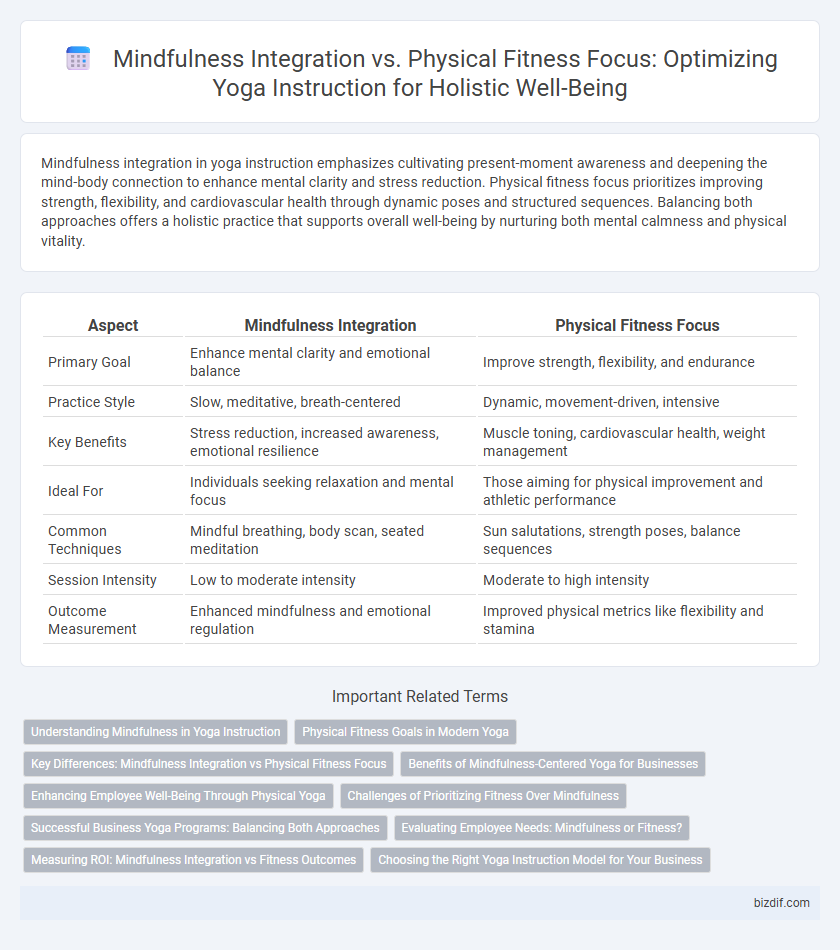Mindfulness integration in yoga instruction emphasizes cultivating present-moment awareness and deepening the mind-body connection to enhance mental clarity and stress reduction. Physical fitness focus prioritizes improving strength, flexibility, and cardiovascular health through dynamic poses and structured sequences. Balancing both approaches offers a holistic practice that supports overall well-being by nurturing both mental calmness and physical vitality.
Table of Comparison
| Aspect | Mindfulness Integration | Physical Fitness Focus |
|---|---|---|
| Primary Goal | Enhance mental clarity and emotional balance | Improve strength, flexibility, and endurance |
| Practice Style | Slow, meditative, breath-centered | Dynamic, movement-driven, intensive |
| Key Benefits | Stress reduction, increased awareness, emotional resilience | Muscle toning, cardiovascular health, weight management |
| Ideal For | Individuals seeking relaxation and mental focus | Those aiming for physical improvement and athletic performance |
| Common Techniques | Mindful breathing, body scan, seated meditation | Sun salutations, strength poses, balance sequences |
| Session Intensity | Low to moderate intensity | Moderate to high intensity |
| Outcome Measurement | Enhanced mindfulness and emotional regulation | Improved physical metrics like flexibility and stamina |
Understanding Mindfulness in Yoga Instruction
Understanding mindfulness in yoga instruction emphasizes cultivating present-moment awareness, breath control, and mental clarity alongside physical postures. This approach integrates meditation techniques and sensory focus to deepen the mind-body connection, promoting stress reduction and emotional balance. Prioritizing mindfulness enhances the therapeutic benefits of yoga beyond physical fitness, fostering long-term mental well-being.
Physical Fitness Goals in Modern Yoga
Modern yoga emphasizes physical fitness goals by integrating strength, flexibility, and cardiovascular health into traditional poses, optimizing body conditioning. Techniques such as Vinyasa and Power Yoga prioritize muscle engagement and dynamic movement, enhancing endurance and stamina. This shift aligns with contemporary wellness trends that value measurable fitness outcomes alongside the mental benefits of yoga practice.
Key Differences: Mindfulness Integration vs Physical Fitness Focus
Mindfulness integration in yoga emphasizes breath awareness, mental clarity, and present-moment focus to cultivate inner peace and stress reduction. Physical fitness focus prioritizes strength, flexibility, and cardiovascular health by engaging dynamic postures and movement sequences. The key difference lies in mindfulness aiming for holistic mind-body harmony, while physical fitness targets measurable physical performance outcomes.
Benefits of Mindfulness-Centered Yoga for Businesses
Mindfulness-centered yoga enhances employee well-being by reducing stress and improving focus, leading to increased productivity and reduced absenteeism. Incorporating mindfulness practices into workplace yoga promotes emotional resilience and better decision-making, fostering a positive corporate culture. Businesses investing in mindfulness-focused yoga witness improved employee engagement and overall job satisfaction, positively impacting organizational performance.
Enhancing Employee Well-Being Through Physical Yoga
Enhancing employee well-being through physical yoga emphasizes improving strength, flexibility, and cardiovascular health, which boosts energy levels and reduces workplace fatigue. Incorporating physical yoga sessions into wellness programs promotes better posture, decreases musculoskeletal discomfort, and supports overall physical vitality. This focus on physical fitness complements mindfulness practices by fostering a balanced, resilient workforce capable of sustained productivity.
Challenges of Prioritizing Fitness Over Mindfulness
Prioritizing physical fitness over mindfulness in yoga practice often leads to increased risk of injury and limited emotional awareness, as practitioners may push their bodies beyond safe limits without attuning to subtle sensations. This imbalance can reduce the holistic benefits of yoga, such as stress reduction and mental clarity, by neglecting the meditative and breath-focused aspects essential for mind-body connection. Furthermore, emphasizing physical achievements may foster a competitive mindset, undermining the inclusive, non-judgmental environment critical for sustained personal growth in yoga.
Successful Business Yoga Programs: Balancing Both Approaches
Successful business yoga programs achieve optimal client retention by balancing mindfulness integration and physical fitness focus, offering holistic wellness experiences. Emphasizing mindfulness enhances mental clarity and stress reduction, while physical fitness components improve strength, flexibility, and injury prevention. This dual approach caters to diverse client goals, driving higher satisfaction and sustainable growth in competitive wellness markets.
Evaluating Employee Needs: Mindfulness or Fitness?
Evaluating employee needs requires distinguishing between mindfulness integration and physical fitness focus to tailor yoga instruction effectively. Assessing stress levels, mental well-being, and concentration challenges indicates a preference for mindfulness practices, while assessing physical health markers and activity levels highlights the necessity of fitness-oriented sessions. Customized yoga programs that align with employees' specific wellness priorities enhance engagement, productivity, and holistic health outcomes.
Measuring ROI: Mindfulness Integration vs Fitness Outcomes
Measuring ROI in yoga instruction reveals distinct benefits between mindfulness integration and physical fitness focus; mindfulness enhances mental clarity, stress reduction, and emotional resilience, contributing to long-term well-being and cognitive performance. Physical fitness outcomes improve cardiovascular health, flexibility, and muscle strength, leading to immediate, observable physical improvements and injury prevention. Evaluating ROI by combining both approaches maximizes holistic health benefits, boosting mental wellness and physical performance metrics for sustainable lifestyle changes.
Choosing the Right Yoga Instruction Model for Your Business
Choosing the right yoga instruction model depends on whether your business prioritizes mindfulness integration or a physical fitness focus. Emphasizing mindfulness integration attracts clients seeking stress reduction, mental clarity, and emotional balance through meditation and breathwork. A physical fitness focus appeals to those interested in strength, flexibility, and cardiovascular health, making it essential to tailor your classes and marketing to the target audience's goals.
Mindfulness Integration vs Physical Fitness Focus Infographic

 bizdif.com
bizdif.com